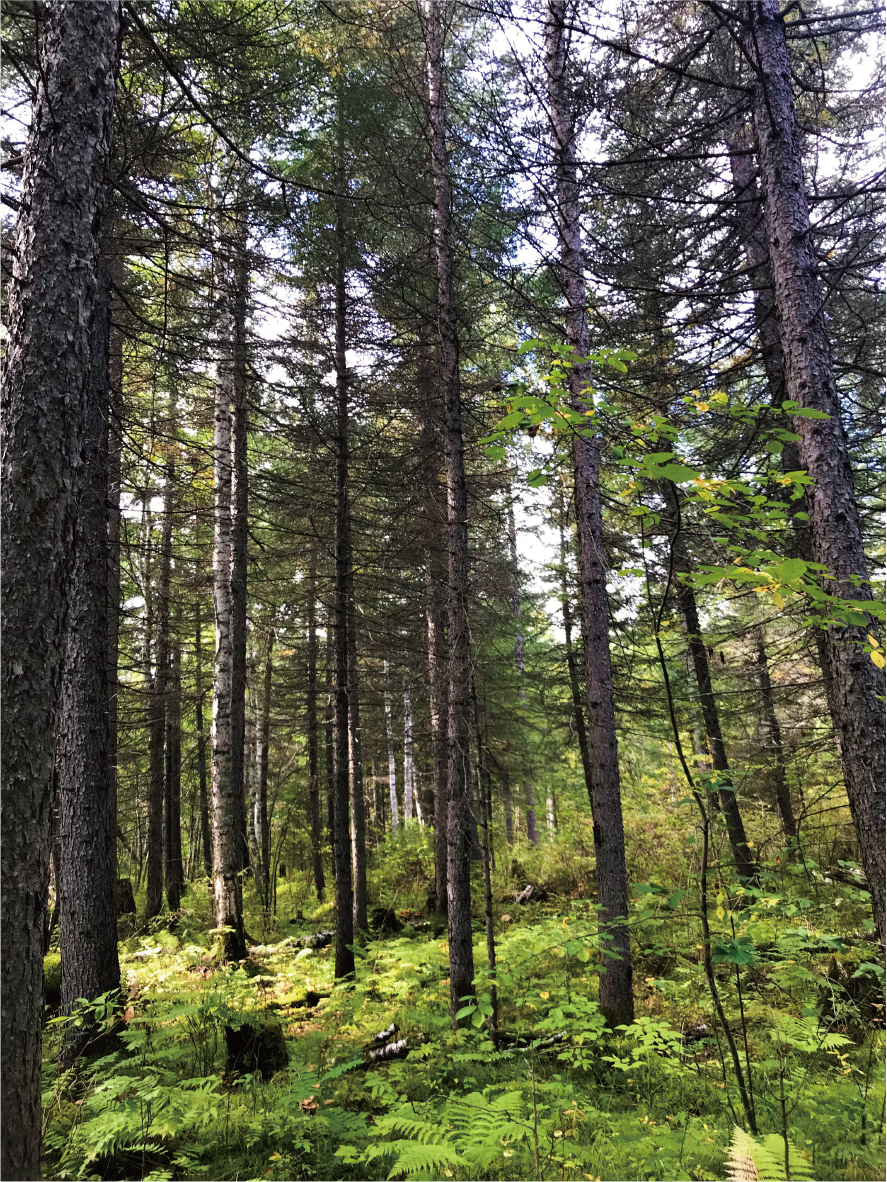

The Vegetation Classification on Picea koraiensis Forest Alliance and Its Environmental Interpretation
Received date: 2021-10-19
Revised date: 2022-04-24
Online published: 2022-04-24
Picea koraiensis Forest Alliance is a forest vegetation type with P. koraiensis as one of the co-dominant species, and is characterized by complex structure and high species diversity. Based on principles for the compilation of Vegegraphy of China, a new vegetation classification scheme of Picea koraiensis Forest Alliance was proposed in this study, including 5 association groups and 8 associations which belong to three Vegetation Formations, i.e., Evergreen Needleleaf Forest, Mixed Deciduous and Evergreen Needleleaf Forest, and Mixed Needleleaf and Broadleaf Forest. The classification of an association group was based on the characteristics of the community stratums and layers, and a group of diagnostic species. Specifically, 66% of importance value for evergreen needleleaf tree layer was used as a threshold for identifying Evergreen Needleleaf Forest and Mixed Needleleaf and Broadleaf Forest. Two-way indicator species analysis was used to identify associations with special consideration to community habitat, successional stage etc. This classification scheme would work as an application example of the principles for the compilation of Vegegraphy of China, and its significances on vegetation classification are as follows. (1) As credentials of vegetation classification, plots must be undergone a strict quality control process before data analysis, which especially holds true for the soundness of species identification; (2) Differences in community stratums and layers, as well as diagnostic species are strongly suggested as the major criterions for the classification of vegetation types for those with complex community structure, high-level species richness but no obvious dominant species; (3) Vegetation types that constructed by special species, i.e., a single Alliance, can belong to different Vegetation Formations; (4) Anthropogenic activities such as deforestation may interfere the relationship between vegetation and environment, thus, disturbances and successional stage of communities should be taken into account in vegetation classification.

Yuan Rongzhen , Wang Guohong , Tang Zhiyao , Wang Qinggui . The Vegetation Classification on Picea koraiensis Forest Alliance and Its Environmental Interpretation[J]. Chinese Bulletin of Botany, 2022 , 57(4) : 468 -478 . DOI: 10.11983/CBB21181
| [1] | 陈灵芝 (1963). 长白山西南坡鱼鳞云杉林结构的初步研究. 植物生态学与地植物学丛刊 1, 69-80. |
| [2] | 陈灵芝, 鲍显诚, 李才贵 (1964). 吉林省长白山北坡各垂直带内主要植物群落的某些结构特征. 植物生态学与地植物学丛刊 2, 207-225. |
| [3] | 段晓梅, 白玉芳, 张钦弟, 张金屯 (2016). 山西太岳山脱皮榆群落的生态梯度分析及环境解释. 植物学报 51, 40-48. |
| [4] | 方精云, 郭柯, 王国宏, 唐志尧, 谢宗强, 沈泽昊, 王仁卿, 强胜, 梁存柱, 达良俊, 于丹 (2020). 《中国植被志》的植被分类系统、植被类型划分及编排体系. 植物生态学报 44, 96-110. |
| [5] | 郭柯, 方精云, 王国宏, 唐志尧, 谢宗强, 沈泽昊, 王仁卿, 强胜, 梁存柱, 达良俊, 于丹 (2020). 中国植被分类系统修订方案. 植物生态学报 44, 111-127. |
| [6] | 侯向阳, 韩进轩 (1997). 长白山西坡风灾干扰区的恢复和保护. 自然资源学报 12, 29-34. |
| [7] | 侯学煜 (1960). 中国的植被. 北京: 人民教育出版社. pp. 68-71. |
| [8] | 黄大明, 韩铁成, 侯世昌, 范德清, 吴力文, 史广飞 (1998). 长白山区白山市的森林资源与林业可持续发展研究. 清华大学学报(自然科学版) 38, 123-127. |
| [9] | 沈泽昊, 张新时 (2000). 三峡大老岭地区森林植被的空间格局分析及其地形解释. 植物学报 42, 1089-1095. |
| [10] | 沈泽昊, 张新时, 金义兴 (2000). 地形对亚热带山地景观尺度植被格局影响的梯度分析. 植物生态学报 24, 430-435. |
| [11] | 王国宏 (2017). 中国云杉林. 北京: 科学出版社. pp. 254-284. |
| [12] | 王国宏, 方精云, 郭柯, 谢宗强, 唐志尧, 沈泽昊, 王仁卿, 王襄平, 王德利, 强胜, 于丹, 彭少麟, 达良俊, 刘庆, 梁存柱 (2020). 《中国植被志》研编内容与规范. 植物生态学报 44, 128-178. |
| [13] | 王国宏, 郭柯, 谢宗强, 唐志尧, 蒋延玲, 方精云 (2022). 《中国植被志》研编规范的若干说明、补充与修订. 植物生态学报 46, 368-372. |
| [14] | 张新时 (1993). 研究全球变化的植被-气候分类系统. 第四纪研究 (2), 157-169. |
| [15] | 中国科学院中国植被图编辑委员会 (2007). 中国植被及其地理格局——中华人民共和国植被图(1:1000000) 说明书. 北京: 地质出版社. pp. 127-145. |
| [16] | 中国森林编辑委员会 (1997). 中国森林-第1卷-总论. 北京: 中国林业出版社. pp. 519-528. |
| [17] | 中国森林编辑委员会 (1999). 中国森林-第2卷-针叶林. 北京: 中国林业出版社. pp. 698-703. |
| [18] | 中国植被编辑委员会 (1980). 中国植被. 北京: 科学出版社. pp. 159-210. |
| [19] | 周以良 (1991). 中国大兴安岭植被. 北京: 科学出版社. pp. 49-87. |
| [20] | 周以良 (1994). 中国小兴安岭植被. 北京: 科学出版社. pp. 54-116. |
| [21] | Whittaker RH 周纪纶译 (1985). 植物群落分类. 北京: 科学出版社. pp. 250-270. |
| [22] | Barkman JJ, Moravec J, Rauschert S (1986). Special issue-code of phytosociological nomenclature. Vegetatio 67, 145-195. |
| [23] | Fang JY, Song YC, Liu HY, Piao SL (2002). Vegetation-climate relationship and its application in the division of vegetation zone in China. Acta Bot Sin 44, 1105-1122. |
| [24] | Federal Geographic Data Committee (2008). National Vegetation Classification Standard, Version 2. http://www.fgdc.gov/standards/projects/FGDC-standards-projects/vegetation/NVCS_V2_FINAL_2008-02.pdf. 2019-10-10. |
| [25] | Kolbek J, Jarolímek I, Valachovič M (2003). Forest vegetation of the northern Korean Peninsula. In: Kolbek J, Šrůtek M, Box EO, eds. Forest Vegetation of Northeast Asia. Dordrecht: Springer. doi: 10.1007/978-94-017-0143-3_8. |
| [26] | Krestov PV (2003). Forest vegetation of easternmost Russia (Russian Far East). In: Kolbek J, Šrůtek M, Box EO, eds. Forest Vegetation of Northeast Asia. Dordrecht: Springer. doi: 10.1007/978-94-017-0143-3_5. |
| [27] | Krestov PV, Nakamura Y (2002). Phytosociological study of the Picea jezoensis forests of the Far East. Folia Geobot 37, 441-473. |
| [28] | Lockwood JD, Aleksić JM, Zou JB, Wang J, Liu JQ, Renner SS (2013). A new phylogeny for the genus Picea from plastid, mitochondrial, and nuclear sequences. Mol Phylogenet Evol 69, 717-727. |
| [29] | Song JS (1991). Phytosociology of subalpine coniferous forests in Korea 1. Syntaxonomical interpretation. Ecol Res 6, 1-19. |
| [30] | Song JS (1992). A comparative phytosociological study of the subalpine coniferous forests in northeastern Asia. Vegetatio 98, 175-186. |
| [31] | ter Braak CJF, Smilauer P (2012). CANOCO Reference Manual and User’s Guide: Software for Ordination, Version 5.0. Ithaca: Microcomputer Power. |
| [32] | Tichý L (2002), JUICE, software for vegetation classification. J Vegetation Sci 13, 451-453. |
| [33] | Tichý L, Holt J (2006). JUICE: program for management, analysis and classification of ecological data. https://www.sci.muni.cz/botany/juice/JC_man1.pdf. 2019-10-10. |
| [34] | Whittaker RH (1978). Classification of Plant Communities. Dordrecht: Springer. pp. 287-399. |
| [35] | Woodward EI (1987). Climate and Plant Distribution. Cambridge: Cambridge University Press. pp. 62-155. |
/
| 〈 |
|
〉 |